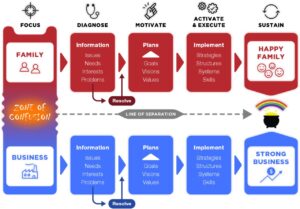Best Practice is a technique, methodology, or approach, proven by research, experience and commonsense, to lead reliably to optimal results.
Family Business Best Practice
Family Business Best Practice produces optimal long term outcomes, for two contrary entities: (a) The Family (emphasis on Family) and (b) The Family Business (emphasis on Business).
Our unique Process Model was developed by working with many families, over many years, to produce a “mud map” to guide them through the minefield, and safely out the other side – provided they stay the course.
Each family’s journey is unique. They all require leadership, guidance, courage, compassion and collaboration. The most profound learnings and greatest benefits come from sharing experiences and reflections, and then acting together to implement what’s been learnt, discussed and agreed.
Family relationships get reviewed, repaired and renewed, as new plans and commitments are made. The future looks hopeful, once again.
Family Business Best Practice Process Model
The process requires that a number of things happen:
- Separate the Family from the Business – to work on each of them, separately.
- Align their respective values, visions and goals to create complementary Plans.
- Establish appropriate Structures and Systems within each entity – to help implement, support, monitor and enforce their individual Plans.
- Ensure the right people are in the right roles, with the right attitudes and skills, in both the Family and the Business, to discharge allocated responsibilities.
Best Practice Process Model – Stages
- Focus (Areas): segregate Family from Business thinking to launch both out of the “Zone of Confusion”, and onto the Best Practice path.
- Focus (Line of Separation): separate Family from Business for all planning, problem solving, and decision making activities.
- Diagnose: identify relevant personalities, relationships, facts, opinions, objectives, issues and problems – for key individuals, the family and the business.
- Resolve: fix serious conflict / relationship / behavioural / other problems, before proceeding.
- Motivate: use Family and Business Values, Visions and Goals to develop go-forward Family and Business Plans, and Succession Plans.
- Activate & Execute: establish key leadership, management and governance Structures, and appropriate Systems, for the Family and the Business. Get the right people, in the right positions, with the right Skills to implement the Plans.
Document key agreements, policies, procedures and commitments.
Monitor, validate and celebrate / reward progress, as it’s achieved. - Sustain: develop a Family Stewardship culture. Establish high quality communications within the Family, and between the Family and the Business. Harness business success to build family harmony and a long-lasting legacy.

